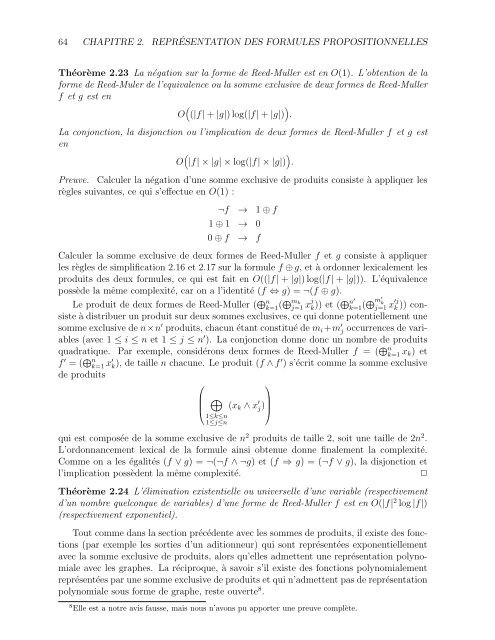Une Boite `a Outils Pour la Preuve Formelle de Syst`emes Séquentiels
Une Boite `a Outils Pour la Preuve Formelle de Syst`emes Séquentiels
Une Boite `a Outils Pour la Preuve Formelle de Syst`emes Séquentiels
You also want an ePaper? Increase the reach of your titles
YUMPU automatically turns print PDFs into web optimized ePapers that Google loves.
64 CHAPITRE 2.<br />
REPRÉSENTATION DES FORMULES PROPOSITIONNELLES<br />
Théorème 2.23 La négation sur <strong>la</strong> forme <strong>de</strong> Reed-Muller est en O(1). L’obtention <strong>de</strong> <strong>la</strong><br />
forme <strong>de</strong> Reed-Muler <strong>de</strong> l’equivalence ou <strong>la</strong> somme exclusive <strong>de</strong> <strong>de</strong>ux formes <strong>de</strong> Reed-Muller<br />
f et g est en<br />
O ( (|f|+|g|)log(|f|+|g|) ) .<br />
La conjonction, <strong>la</strong> disjonction ou l’implication <strong>de</strong> <strong>de</strong>ux formes <strong>de</strong> Reed-Muller f et g est<br />
en<br />
O ( |f|×|g|×log(|f|×|g|) ) .<br />
<strong>Preuve</strong>. Calculer <strong>la</strong> négation d’une somme exclusive <strong>de</strong> produits consiste à appliquer les<br />
règles suivantes, ce qui s’effectue en O(1) :<br />
¬f → 1⊕f<br />
1⊕1 → 0<br />
0⊕f → f<br />
Calculer <strong>la</strong> somme exclusive <strong>de</strong> <strong>de</strong>ux formes <strong>de</strong> Reed-Muller f et g consiste à appliquer<br />
les règles <strong>de</strong> simplification 2.16 et 2.17 sur <strong>la</strong> formule f ⊕g, et à ordonner lexicalement les<br />
produits <strong>de</strong>s <strong>de</strong>ux formules, ce qui est fait en O((|f| + |g|)log(|f| + |g|)). L’équivalence<br />
possè<strong>de</strong> <strong>la</strong> même complexité, car on a l’i<strong>de</strong>ntité (f ⇔ g) = ¬(f ⊕g).<br />
Le produit <strong>de</strong> <strong>de</strong>ux formes <strong>de</strong> Reed-Muller ( ⊕ n<br />
k=1 ( ⊕ m k<br />
j=1x j k )) et (⊕ n<br />
k=1( ′ ⊕m′ k<br />
j=1x ′j<br />
k )) consiste<br />
à distribuer un produit sur <strong>de</strong>ux sommes exclusives, ce qui donne potentiellement une<br />
somme exclusive <strong>de</strong> n×n ′ produits, chacun étant constitué <strong>de</strong> m i +m ′ j occurrences <strong>de</strong> variables<br />
(avec 1 ≤ i ≤ n et 1 ≤ j ≤ n ′ ). La conjonction donne donc un nombre <strong>de</strong> produits<br />
quadratique. Par exemple, considérons <strong>de</strong>ux formes <strong>de</strong> Reed-Muller f = ( ⊕ n<br />
k=1 x k ) et<br />
f ′ = ( ⊕ n<br />
k=1 x ′ k), <strong>de</strong> taille n chacune. Le produit (f ∧f ′ ) s’écrit comme <strong>la</strong> somme exclusive<br />
<strong>de</strong> produits<br />
⎛ ⎞<br />
⊕<br />
⎜<br />
⎝ (x k ∧x ′ ⎟<br />
j) ⎠<br />
1≤k≤n<br />
1≤j≤n<br />
qui est composée <strong>de</strong> <strong>la</strong> somme exclusive <strong>de</strong> n 2 produits <strong>de</strong> taille 2, soit une taille <strong>de</strong> 2n 2 .<br />
L’ordonnancement lexical <strong>de</strong> <strong>la</strong> formule ainsi obtenue donne finalement <strong>la</strong> complexité.<br />
Comme on a les égalités (f ∨g) = ¬(¬f ∧¬g) et (f ⇒ g) = (¬f ∨g), <strong>la</strong> disjonction et<br />
l’implication possè<strong>de</strong>nt <strong>la</strong> même complexité.<br />
✷<br />
Théorème 2.24 L’élimination existentielle ou universelle d’une variable (respectivement<br />
d’un nombre quelconque <strong>de</strong> variables) d’une forme <strong>de</strong> Reed-Muller f est en O(|f| 2 log|f|)<br />
(respectivement exponentiel).<br />
Tout comme dans <strong>la</strong> section précé<strong>de</strong>nte avec les sommes <strong>de</strong> produits, il existe <strong>de</strong>s fonctions<br />
(par exemple les sorties d’un aditionneur) qui sont représentées exponentiellement<br />
avec <strong>la</strong> somme exclusive <strong>de</strong> produits, alors qu’elles admettent une représentation polynomiale<br />
avec les graphes. La réciproque, à savoir s’il existe <strong>de</strong>s fonctions polynomialement<br />
représentéespar unesommeexclusive <strong>de</strong>produitset quin’admettent pas<strong>de</strong> représentation<br />
polynomiale sous forme <strong>de</strong> graphe, reste ouverte 8 .<br />
8 Elle est a notre avis fausse, mais nous n’avons pu apporter une preuve complète.


